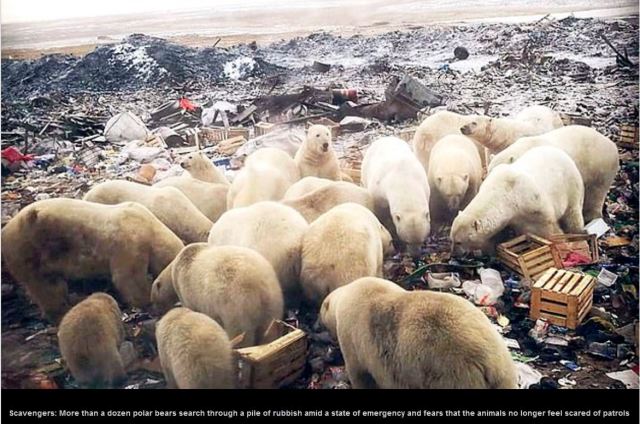Polar bears walking the streets on Novaya Zemlya are habituated garbage bears, not victims of climate change
Polar bears walking the streets on Novaya Zemlya are habituated garbage bears, not victims of climate change

Seriously, if the bears were coming for us, people in Belushaya Guba would have died already, probably EATEN. These particular bears know there is stored food and refuse available that does not come packaged in human form and they know from experience that humans won’t hurt them. As I pointed out in my last post, these bears have known this since early December, when they chose to stay on land over the winter and ignored the sea ice when it arrived.
Lack of sea ice is not the problem here. These are habituated garbage bears that are no longer safe to have around: the responsible option is to shoot them. It’s harsh, I know, but the population will recover from the loss.

If you suddenly cut off their passive food supply (fence or close the dump, deal more carefully with individual refuse and stored food), all of these bears in the photos and videos being flashed across the Internet will become desperate and truly dangerous. Remember, just last summer an emaciated, desperate bear almost killed a cruise ship guard: he had a loaded gun and was actively looking for bears, yet the bear managed to ambush him. He’d have died if he’d been alone.
Of course the refuse and stored food problem needs to be dealt with, in Belushaya Guba and elsewhere across the Arctic, but these particular bears cannot be saved. Cleaning up these issues takes time, coordination, and money. Ask Churchill, Manitoba, who for years wrestled with these issues before a workable solution was agreed upon. And while few Arctic communities can afford to do it the Churchill way, virtually all must contend with the very real threat of polar bears both inside and outside their communities. Ask the Inuit of Arviat and Naujaat, who each lost a young man last summer to a predatory attack by a polar bear that happened well outside their respective villages and where lack of sea ice was not an issue.
Blaming this on climate change is the Paul Nicklen starving polar bear video all over again. You remember the one, the video that National Geographic got so much push-back about that they had to make a public apology for spreading misinformation?
Do climate change promoters really need another fiasco featuring polar bears?
Are they really thinking this incident will somehow be ‘the one‘ that will convince the public that climate change should be a priority for them? They clearly do not understand that this is the same ‘public’ who have seen black bears and/or grizzlies at town dumps, and know that scavenging is a common behaviour of all bears. The public who probably have experience with what happens when you clean up community garbage tissues without destroying the particular bears who are habituated to it – they start attacking people. The public who knows that relocating habituated bears doesn’t work – they always find their way back, either to the dump they know or another one. Google ‘dump bears.’
Still no further word from Russia on this incident, everyone is still rehashing the original report: there has been ice right off Belushaya Guba since 11 February. But I’m guessing the bears won’t be leaving of their own accord (see previous post for location of Belushaya Guba and other sea ice charts).

Footnote 1. Yes, WWF has assisted some communities protect themselves against polar bears but their role is primarily educational. In Arviat in 2014, WWF funded the cost of one paid community patrol guard, out of the four deemed necessary (pdf here). WWF likes to pat itself on the back for its work on this problem but while its better than nothing, the costs involved in securely storing food and garbage, as well as hiring patrol personnel, are probably the biggest hold-up for most communities. WWF brings in tens of millions every year but spends a pitance on keeping Arctic residents safe from polar bears.



